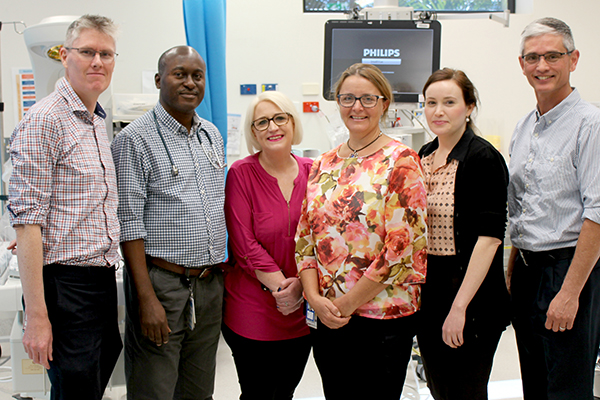Patients share experiences for improvements
Redcliffe Hospital is leading the way when it comes to improving the way sepsis is identified and treated in Queensland hospitals.
Since signing on with Clinical Excellence Queensland’s Sepsis Collective in September 2018, Redcliffe’s progress has been scored the best of all 16 hospitals involved.
An audit earlier this year showed sepsis pathway utilisation at Redcliffe Hospital had increased from 40% to 80%, with better than 80% patients now receiving the fluids and antibiotics they need within the recommended best-practice time guidelines.

Redcliffe Hospital’s multi-disciplinary sepsis team in 2018.
Project Support Officer at Redcliffe Hospital, Helena Cooney says the frightening thing about sepsis is that anyone can be a patient.
“They can be young, fit, and healthy and then, they’re not,” Helena said.
“Sepsis starts as an infection somewhere in the body. From there, the infection can enter the bloodstream and progresses quickly to cause organ damage and failure. By the time we see a sepsis patient in the Emergency Department, they can be very unwell and deteriorating fast.”
“Time is critical for sepsis patients.”
Helena was Redcliffe Hospital’s Sepsis Clinical Nurse Consultant, working alongside a multidisciplinary team of clinicians from pharmacy, paediatrics, ICU, and Emergency to implement the adult and paediatric sepsis pathways at Redcliffe Hospital.
“The Pathways are the key to identifying and intervening in sepsis patients before organs start to fail. Before we rolled out the pathway, we estimated we would be screening around ten patients with sepsis each week.
“When we implemented the pathways, our Emergency Department was identifying more than ten patients each day where sepsis was indicated. These patients are now seen quickly by a senior medical officer – like we do when patients present with chest pain or suspected cardiac emergencies.
“To implement the adult and paediatric sepsis pathways fully, we ended up making 34 specific changes to our practices in the Emergency Department.”
Rolling out the sepsis pathways at Redcliffe Hospital began with an eight-week intense program of education and training to clinicians across the Emergency Department.
“From patient screening to diagnostics, blood cultures, and delivery of appropriate antibiotic treatment – it was a very practical focus on every step in the sepsis pathways,” Helena said.
“We delivered 86 in-services, including Grand Rounds for medical officers in the first 12 months.”
“Our aim was to reach at least 80% of our Emergency Department staff, prior to roll out, we reached more than 95%
Helena said while the focus was on the Emergency Department, education had been delivered to every ward and service in the hospital.
Sepsis used to be something that ICU clinicians knew about, now every ward and service in the hospital is part of the fight against sepsis.
QUALITY OF CARE
TABLE OF CONTENTS
